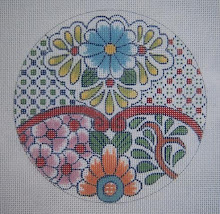 I've been working on this one, and have now gone all the way to the bottom of the sea. I have to remind myself that it's just an experiment in developing a new idea, as I'm not totally happy with the abrupt change from medium values to dark, as I switched colors and ran out of room. I think it would have been a lovely transition if it were on a bigger space. Oh well. It will be covered up by sea fans, etc. anyway.
I've been working on this one, and have now gone all the way to the bottom of the sea. I have to remind myself that it's just an experiment in developing a new idea, as I'm not totally happy with the abrupt change from medium values to dark, as I switched colors and ran out of room. I think it would have been a lovely transition if it were on a bigger space. Oh well. It will be covered up by sea fans, etc. anyway. By running out of room, I mean that I had made two "ripples" with each change in the number of plies used - but only one when I started the last two shades, which were the teal/greenish.

I think the reason I was determined to do this shading on a diagonal, is that I was loving the photographs I saw taken by skuba divers when I was researching sea fans. Upon further study, I discovered that sea fans grow perpendicular to the current, so as to ensnare micro organisms for food. This could account for the angle of the light to dark of the water.

Before reaching the line of the sand, I made a stopping place of tent stitch, as I do not like the appearance of textured stitches that are placed against each other without it - they look incredibly messy. The upper "slope" of sand will be in basketweave, as it's an anchor for the sea fans and coral, so doesn't need the "outlining."
In the third photo, I'm showing how this stitch - whatever it's called (I made it up for this project, but I feel sure it's somewhere in a book or two with some grand sounding and complicated name) developed into something surprising that I could utilize to keep track of the progression of the shading.
Also - it demonstrates why a good knowledge of basketweave is essential. Coming DOWN the canvas from upper left to lower right on the WARP gives this appearance - a little sawtooth edge. Then, going back up - on the WEFT - it fills it in almost solid, so give a kind of watery ripple effect. I found that I had done two "ripples" or ridges each for the two aqua threads, but when I got to the darker greenish teal ones, I was running out of room - and in a hurry anyway - so only did one each. This accounts for the abrupt shading down to dark.
 In the fourth picture, at the upper left, the arrow points to the first ridge in which I changed the ply count to 3 light, and 1 of the next shade to begin the blending and shading. The next arrow points to the WEFT - the dip - where one travels back UP the row. You can see how easily it fills it in.
In the fourth picture, at the upper left, the arrow points to the first ridge in which I changed the ply count to 3 light, and 1 of the next shade to begin the blending and shading. The next arrow points to the WEFT - the dip - where one travels back UP the row. You can see how easily it fills it in. On the lower right, the arrow points to the tent stitch separating the texture of the water from the intended Nobuko that will be the sand at the bottom of the sea.
The last photo shows the sand begun in Nobuko stitch, which makes it look much lighter than the sloping part - due to the light striking the long stitches and making them brighter, whereas in basketweave, in the same exact thread, they look darker and duller due to the light being broken up. It's amazing what one can do with just one kind of thread! The arrow on the left shows where I began the tent stitch outline of the circle, as it's necessary here to confine the Nobuko stitches neatly.

I think the next step here is to put it away for a little while, and start making some sketches to use to remind myself not to go totally nuts when beginning the coral/sea shells/sea fans/seaweed, etc. (and maybe a little brightly colored fish or two) I am prone to get excited and want to put all of it onto one poor little 4" ornament. One must develop patience.

4 comments:
Hi Judy,
Your wonderful pictures show the shading process beautifully!
I'm wondering if the abrupt shading goes away when you cover it up with the coral, sea shells, sea fans, and seaweed???
It will be fun to see what you add.
:-)
Cynthia
Windy Meadow
Lovely shading. I think the stitch you are using for the "water" is a Diagonal Mosaic. Over 1, over 2, repeat?
No - it isn't diagonal mosaic, as when I travel back up on the weft, I still cover two stitches, so the count is 2-2-2 going both ways. It gives me a smoother edge and a better "ripple" effect. (this was a nice surprise)
I think the colors are appropriate to the shading effect. Looks good. Can't wait to see it finished..
Carolyn
http://www.stitchopedia.com
An encyclopedia of needlepoint stitches…
Post a Comment